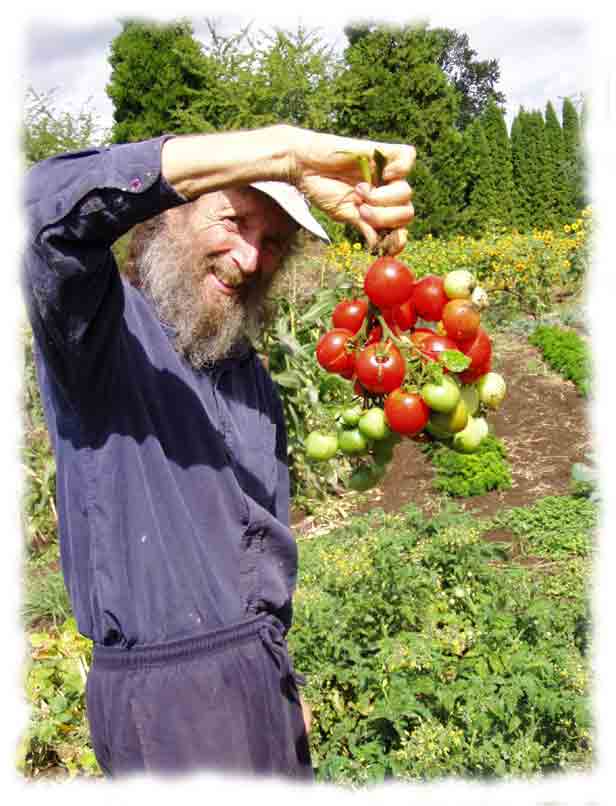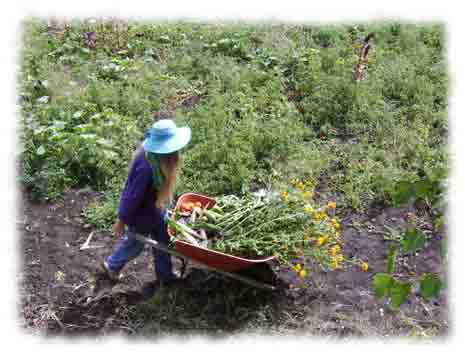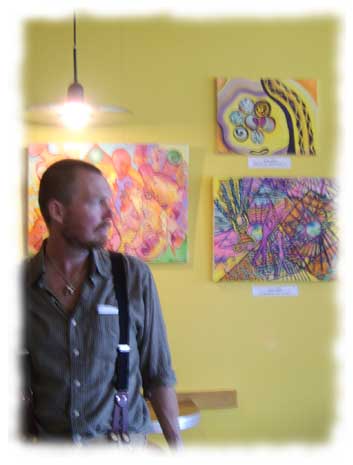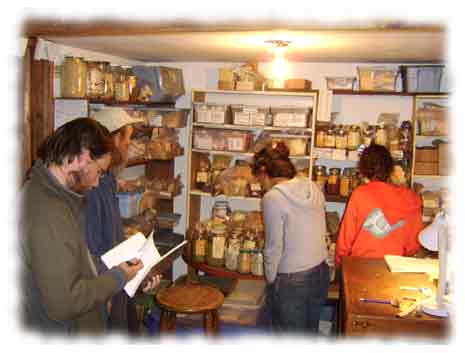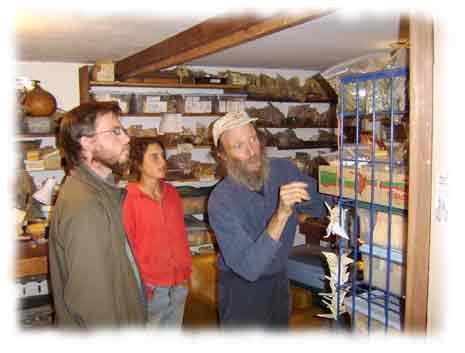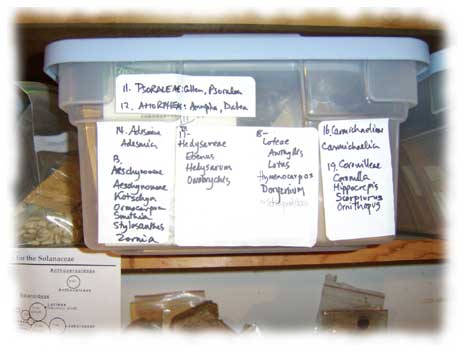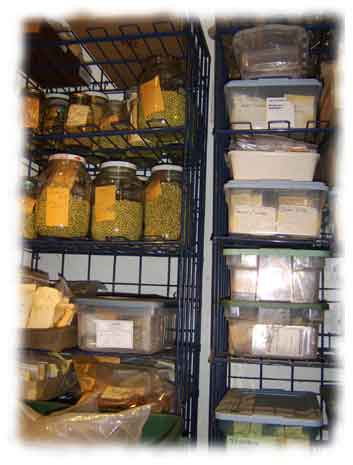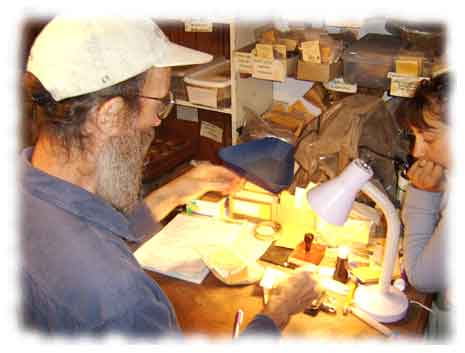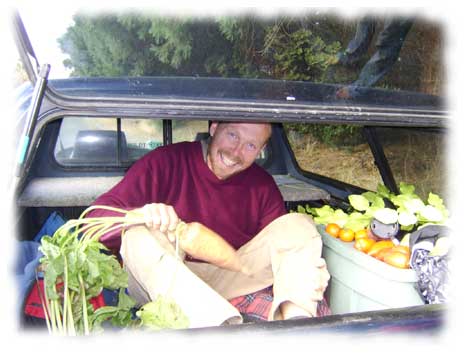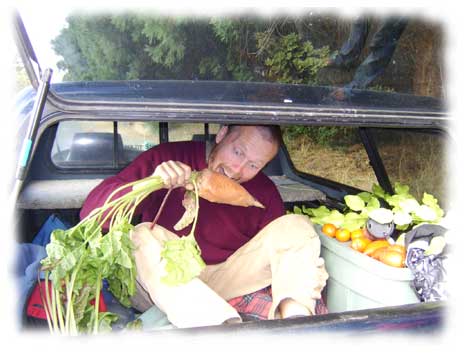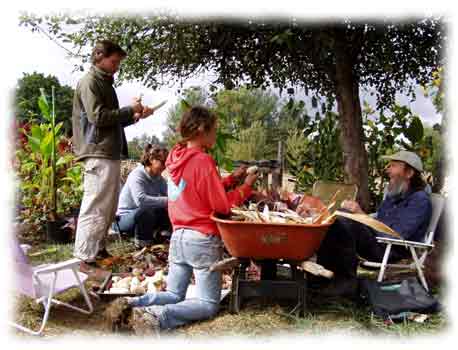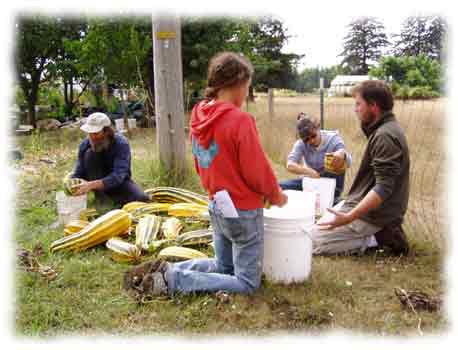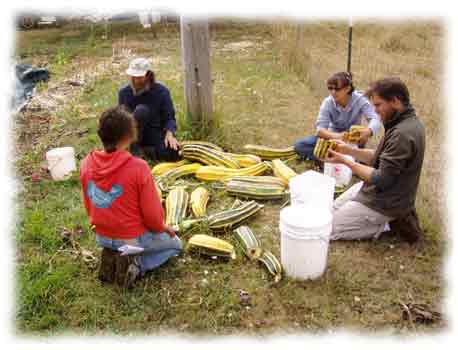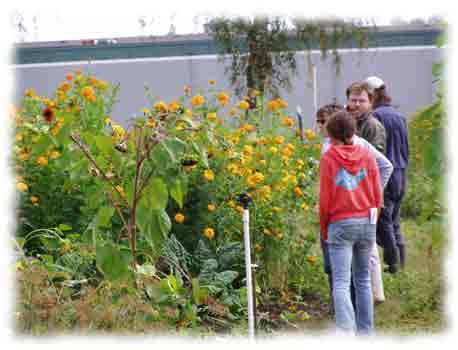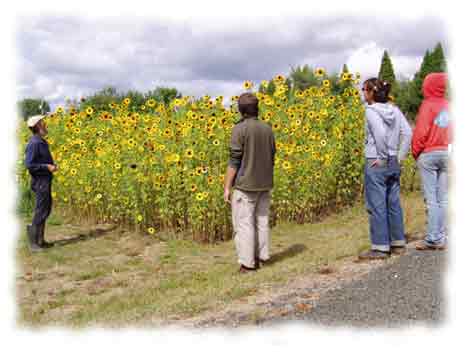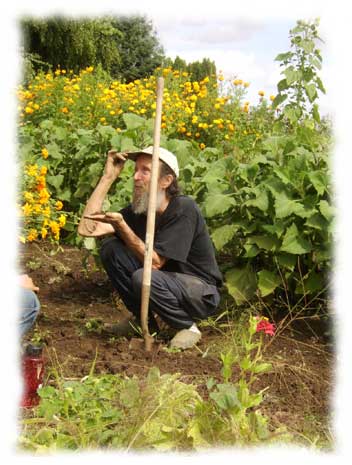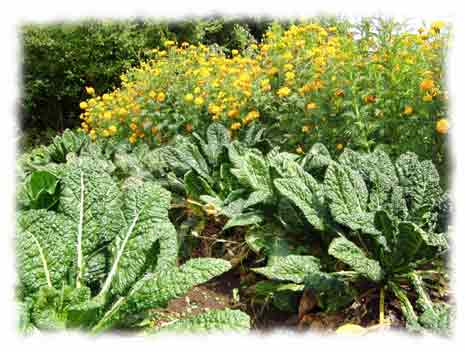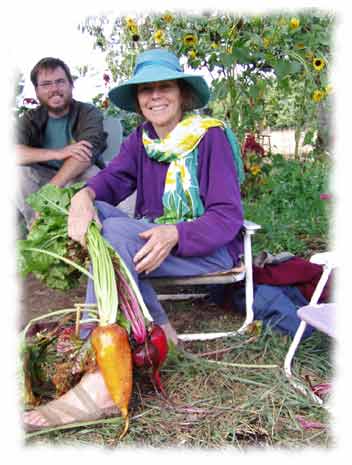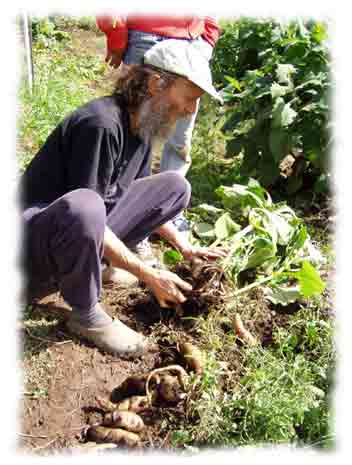| The following article appeared in the Spring 2005 issue of Permaculture Activist, #55, devoted to ‘Learning from Our Mistakes.’
“Life, my little man, lacks rehearsals. That ís why it so often fails. Now, in the theater . . .” Rene de Obaldin, Exobiographie Seminal adj. Of, relating to, containing, or conveying semen or seed. 2. Of, relating to, or having the power to originate; creative. 3. Highly influential in an original way; constituting or providing a basis for further development: a seminal idea in the creation of a new theory. (American Heritage Dictionary)
One afternoon, this past July, when the earth was warm and I was warm, I found myself weeding onions across from two men and then later, harvesting milk-thistle seed together. Wise, gentle, and deeply devoted to the green world, these two magnificent souls. I swam in their companionship and our work and, as we shared around the topic of plants and health, talk quickly became naked, confessional. It wasn’t long before I learned that the third member of our group, a new face, has also been dealing with chronic prostate/reproductive health issues. A majority of men have trouble with their prostate sometime in their lives. James Green writes: “It is said that men ‘push their worries into their prostate,’ our uniquely male chamber of silence where we store our most private concerns.” And much as recent years have born witness to a great increase in cancer, depression, and auto-immune disorders among others, intuition does suggest that that both my and my friends’ individual prostate health is also tied inexorably to a story much larger than ourselves, to a malaise of our epoch, to a genuine crisis in the masculine spirit. As the introductory words to Stephen Harold Buhner’s book, Vital Man: Natural Healthcare for Men at Midlife, put it: “I cannot write about men’s health without also writing about being a man; the two are inextricably intertwined.” It came as no great surprise to me that three of us, men between the ages of 20 and 42, are dealing with a health issue typically labeled as middle- and late-aged concern. One reason I was not as surprised by the discovery of our shared struggles as I might have been is because I knew a little bit about the life and work of these two men. They are, fundamentally, healers, and the archetype of the wounded healer not only defines so much of their and my own trajectory but so very many of the tribe we move among. As we say of the shaman-healer, “The shaman’s ability to deal with disease stems directly from her or his intimate experience of it,” an echo here, of Nietzsche’s “Whoever has built a ‘new heaven’ has found the strength for it in his own hell.” Where sickness originates is where health can be regained, and in the self-cure is the healing wisdom that makes of us healers not only of ourselves but, potentially, of others. Could it be that our culture’s blindness to this truth stands at the heart of a crisis in perception, paralyzing our efforts to respond constructively, both as individuals and collectively, to the Errors of Our Ways? Wisdom traditions have useful insights here. As Elisabeth Kubler-Ross observes, “There are no mistakes, no coincidences. All events are blessings given to us to learn from.” In fact, as our understanding of the nature of the world and existence evolves, so the whole kit and caboodle of knee-jerk assumptions bound up in the label “mistake” begin to look very hasty and superficial indeed. As Blake noted, “A fool sees not the same tree that a wise man sees.” Not a few wise souls insist that unfortunate turns of event aren’t simply opportunities for growth, but essential for it. The Tibetan master Chogyam Trungpa goes so far as to say, “Disappointment is the best chariot to use on the path of the dharma.” Others concur. John Ralston Saul: “I do not sense that we seek the comfort or the false freedom of denial. We understand the truer comfort of a permanent psychic discomfort in which we seek to identify reality. And we deal with reality through the creative tensions with which we attempt to balance our qualities. This is our eternal movement toward equilibrium.” Put simply, all circumstances, even the most trying, are tools for wisdom to work with. Trungpa again: “We must surrender our hopes and expectations, as well as our fears, and march directly into disappointment, work with disappointment, go into it and make it our way of life.” Likewise, a contemporary Sufi: “If we’re paying attention (learning), then nothing is a mistake. If we’re not paying attention (learning), then everything is a mistake. The lessons that we tend not to forget are the most painful. When we realize this, pain becomes pleasure, for it is the best teacher. The broader our perspective the less mistakes seem like mistakes, rather they become the instruments for evolution.” Naturally, this also holds true of our attitude to others’ errors and to life’s ‘blameless’ circumstances as they touch us. Of course, no one suggests that broadening the perspective in this way comes easily. The transpersonal psychotherapist John Welwood: “When we explore the roots of disappointment, we tend to come up against the pain of a tangled pattern of actions and reactions, accumulated conditioning, habit, unconsciousness and fear. As one spiritual wag put it, ‘Self knowledge is always bad news,’ at least initially.” As I worked alongside my men-friends in the dirt, what I already knew of their lifestyles told me they were on the healing path, even as the deep stories informing their trajectory remained unclear to me. What of their childhoods? Their relationships with their fathers? I’m keenly aware that I simply lack the poetry to communicate the great, poignant meaningfulness of life’s twists and turns, but in my own instance, I have come to see that my own prostate dysfunction is less a symptom of two decades of sexual obsession than of the agonies informing it: the sorrows, fears, regrets, and griefs unresolved, the legacy of early wounds and my own stumbling, often shabby efforts to embrace the givens of my life. As an Old Soul might put it, a message of chronic prostate problems in one’s thirties might be, “You are mistaken. The healing you seek as a man is not to be found in the way you have chosen to live. Try again.” A Personal Pathology Because I live the life of a mendicant and because no insurance policy, public or private, claims me, the for-profit healing establishment simply puts itself out of the running for me, no matter what its strengths. Dealing with chronic health issues in recent years, I’ve always been forced to walk toward the free. As it happens, I’ve found this “straightjacket” to be the greatest of blessings because I find myself, willingly or not, constantly ushered into an ecological or “root response” to what ails me, toward fundamental changes in sensibility and lifestyle. I am not able to buy myself out of my symptoms. At the time my own reproductive problems first surfaced, I looked to address the immediate pathology. Much, deep pain. My ejaculate, a bright, deep crimson. Life-threatening, I thought. How in the heck am I going to tackle this one? I began by turning to where I’ve always been able to find care, to the heart of the local botanical medicine community. To the women. And it was there that I found a lesson in the making. I quickly discovered that while there exists a mother-lode of both general and highly localized know-how around the use of botanical medicinals for women, the men are, quite simply, out in the cold. Many are the reasons for this. For one, as you may already be aware, the witch-hunts of the ages have been predominantly male endeavors. “Witches” were, for the most part, simply the midwives and herbalists of their day. Francis Bacon, the founder of the modern scientific method, had a governmental role as overseer of juridical torture of accused “witches.” It was he who suggested that torture devices be used in interrogating women to find nature’s secrets. I’m told that many of the earliest herbals emerged around this time—the details tortured from women. “Nature must be placed on the rack, tortured, and forced to give her secrets to the scientists, put in constraint, made a slave, and controlled” said Bacon, in words that still stand as a definitive critique of the sensibility informing the Modern Method. The paradigmatic legacy of such thinking, and the consequences for the direction and focus of botanical medicine, are still felt to this day. When I visited Michael Moore’s website (one of the web’s richest touchstones of botanical medicine-making know-how) to research formulas for reproductive health, along with the many for women, I found not a single formula for men. Prostate cancer is the number two killer of American males. [Afterward edit, August 2006. It appears my use of the quote from Bacon above, is mistaken. I did not check my sources for this quote, when I lifted it from the work of another writer. Evidence suggests I did the memory of the man a great disservice, even as the quote does, I believe, indeed reflect the spirit of inquiry of the time.]
Although times are a’changing, there’s still very little in the way of relevant gnosis around men’s botanicals to be found. A couple of key, generalist texts, and that’s it. The mainstay fallback for 99% of men’s health formulas for western herbalists is saw palmetto, the berry of a palm, Serenoa repens, found commonly in semi-tropical, coastal Florida. No one could tell me much more. To cut a long story short, I consistently find that the aspiration to go local leads me toward deeper authenticity in all areas of my life. And when I’m being honest with myself, I try always to seek alternatives to healing modalities that call on non-local medicine. I tackled the Pacific Northwestern palm geeks. A Serenoa was spotted close to my whereabouts some years ago, but palm-geek consensus seems to be that we lack the heat hereabouts for it to fruit. There’s an outside chance we might pull something off under plastic—is there a hardier variety lurking somewhere? But plastics aren’t my long-term cup of tea, I haven’t yet stumbled into a hardy Serenoa, and I’m not up to moving to Florida. What are the local alternatives I need to be moving towards? As it happens, no one could tell me. And our local lay of land speaks a very great deal about the poverty of men’s wisdom around this topic, everywhere. Sneeze in my neighborhood and you’ll more than likely find a medicine-maker taking you by the elbow and handing you a hankie and an herb. It’s not that we don’t have fine herbalists who are men, but perhaps that, until one or several local male healers wrestle mightily with chronic reproductive health issues, we will never have a first-class source of experiential bioregional know-how around men’s health concerns, a gnosis prioritized and informed by personal and pressing need. Admittedly, I can be accused of suggesting the challenge rests with someone else, but surely, the current crisis in male reproductive health is a collective incoherence that necessarily begs a collective response. More to the point, it’s impossible for any individual to have this story in hand: It’s simply too big to be lived by any one of us. In the very simplest terms, what’s our local ecology telling us now about how it can help us? Which plants does it make sense to cultivate, which to wild-craft? Which plant and lifestyle combinations work best in the dance of inner and outer ecologies? There exist a myriad of factors relating to the unfolding of an effective healing modality—to birthing, fundamentally, a healthy male culture—and we’re all steering. What we do know is that existing male reproductive formulas are driven by non-local protocols for the most part, and that few of the pieces of the bioregional dimension to male health have so far been assembled, never mind synergistically combined in an integrated healing melange. As such, when I found myself in that field with those two men, one of whom is a master-herbalist in the making, I felt the universe had finally stumbled me into a concerted step forward in the cause of “bioregional prostate support,” for want of a better phrase. Between us, and our close associates, we have the beginnings of a solid sense of how the gentlest local medicinals for men might be crafted, and a compelling personal rationale to explore this route together. I sense that our current local endeavors are not without implications that extend through space and time to the very heart of the co-evolutionary impulse in our bioregion, and elsewhere. My personal experience, for example, suggests that moving toward a local response to chronic health concerns actually reveals an intimate relationship between my healing as an individual, and the healing of the culture in which I live, both human and green. This journey has been inextricably tied to a deepening awareness of permaculture’s role in advancing the evolutionary image of what it is, fundamentally, to annihilate the distinction between inner and outer healing. What do I mean? As I have begun to explore which local plants, synergistically combined, make good medicine, I’m also looking at how to grow them, in combinations, synergistically, in the garden. What are botanical medicinal formulas, which resonate with human systems. telling me about potential plant guilds, which resonate with greenworld systems? Do functional taxonomy/herbal ecology geeks hold an important key to restoring lost links in the Great Chain of Being? Which combinations of plants, just like those in herbal formulas, can be planted together —guilded—synergistically to help damaged ecosystems? Immune system stimulants? Adaptogens? I’m finding that Traditional Chinese Medicine has a great deal to say about formulas, as well as specific medicinals. Is the foundation for a marriage of Eastern and Western (and indigenous and Ayurvedic and other) healing modalities to be found in a communion of Eastern and Western deep gardening know-how, and vice-versa? And by extension, might such an adventure in beauty and truth presage a truly gentle communion of global cultures—one rooted, harmoniously, in the dirt? What other co-creative patterns interconnect and nurture our inner and outer ecologies? There’s nothing new to this notion of inner-outer symbiosis to the indigenous crew, of course. I’m reminded of the Lakotan term, wakonda, variously translated as a divine object; the life force—and at other times as the process manifested to invoke that force; or “making medicine,” where the act of healing a person, either oneself or someone else, is ultimately regarded as the same act as healing the earth, where making medicine locally has the ability to heal us in particular ways by linking us directly to the healing spirit of where we live. Stephen Buhner tells me: “It’s no coincidence that St. John’s Wort grows around depressed alcoholics so much, nor that it tends to congregate in depressed ecosystems.” Our reproductive health and the regenerative health of our ecosystems are intimately related. We exist in analogical context: healing is an ecological act. Just now, as I reflect upon my ecology of healing in recent years, I’m surprised to note how work with the seed archetype has become central to my life. The accompanying sidebar hints at some aspects of the dance and illustrates, perhaps, how the journey toward authentic health manifests as a transformational archetype rooted and seamlessly interrelated in all realms of experience—the physical, the mental, the spiritual and the emotional. In a garden recently, I was sharing about anger with one of the men whose character and horticultural life I respect deeply. We were admitting some harsh truths about ourselves, about our reflection in the world in which we move. And this icon to me confessed that last year he came to despair that every time he went near a plant, he seemed to hurt it. After a pause, I responded. “Yes. That feeling is not unfamiliar to me. Remorse is a feeling that informs much of my experience around the Garden.” Deep gardening for this man, and myself, is a monumental struggle, a constant step into our Shadow. Rumi cuts right to the heart: “An empty mirror and your worst destructive habits, when they are held up to each other, that’s when the real making begins… Don’t turn your head… That’s where the light enters you.” As Jung observed, it is only by bringing our Shadow into the light of truth that we are healed. And my friend and I know that although the Garden may be merciless in her grace, she is also an eternally forgiving lover who steadfastly ushers us, in our failures, not into a simulacrum of health in body and mind, but the real thing, folks. In truth, “dealing with yer stuff” has long been recognized as the foundation stone of authentic religious practice—the disciplined application of techniques designed to transmute our “poisons” into, for want of a better turn of phrase, the flowering of integrity. Sages actually speak of the manifest advantages of having negative traits with which to work. Simply put, the more we have to recycle, the more compost we bring to the garden. The benefits of bigger compost piles are alluded to in the religious adages: “Better to have fallen and learned, than never fallen,” and, “At the end of the valley of sin, do not be surprised if you find virtue standing.” Do not inhibit, but transmute, say the Sages. Do not entertain the insanity of the Sages. And men, of course, do not compost alone. In the blessed living trajectory that has carried me through the gutters and palaces and loving arms of cultures the world over, in countless sharings, I have come to see clearly that the wounds which stand at the heart of that which separates women and men from beauty, are the wounds of our sex. And in the inimitable words of Robert Bly: “Our wounds are our gifts.” So much in the way of wisdom, gentleness and compassion is yet to be born in this crucible of shared sorrows and joys. And, surprise, surprise, this common ground of the red-blooded masculine and feminine experience finds archetypal communion in the green-blooded garden. It transpires that many of the herbs for female reproductive health are the very same herbs that work for men. As the wisest women and men concur, the healing of the deep masculine is intimately related to the healing of the deep feminine, and likewise. We meet in Nature and in a shared, active, localized, relationship with healing into our ground of being—the way out of our problems is the way into our solutions, as above so below, as inner so outer, as male so female. We are reflections, one of the other. This is more than a tidy ontological truth relating specifically to the regenerative health of women and men and our world. As Jelaluddin Rumi observes: “All our defects are the ways the glories get manifested.” Indeed, the story around the reproductive archetype suggests not only, as John Keats insists, that “Failure is, in a sense, the highway to success,” it also shines the brightest of lights on another key law governing our linked existence—the more diverse and varied the ailments of humanity, whatever they are, the richer and stronger the integrative, healing impulse and co-intelligence we can transmute into the healing of Gaia; and vice versa. With the subtlest of shifts in perception, we rebaptize our negative traits as positive ones. The answer, in other words, uproots the question. As deep gardeners, we simply seek beauty twice-realized or, as William Irwin Thompson puts it, the collapsing of two-dimensional vanities. The Universe, most elegant in economy. Nick Routledge is a seedsman in Springfield, Oregon. |

